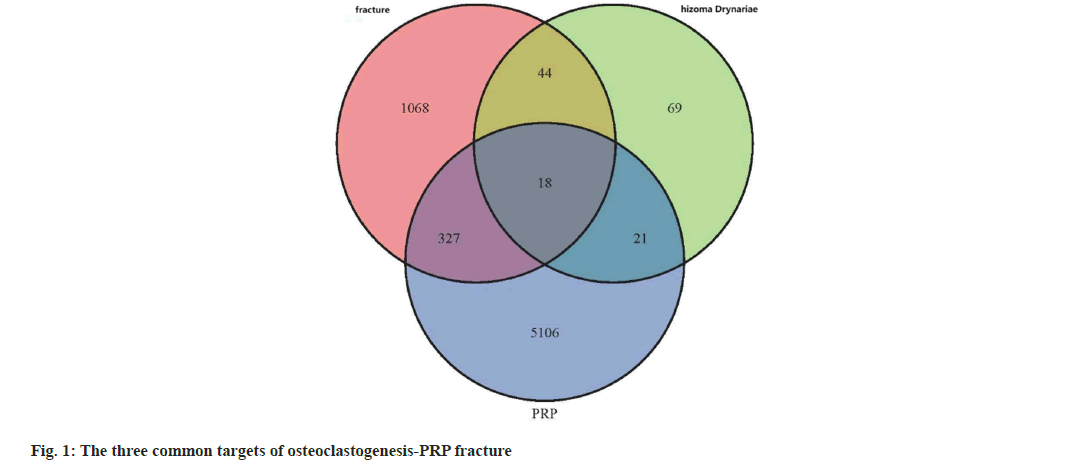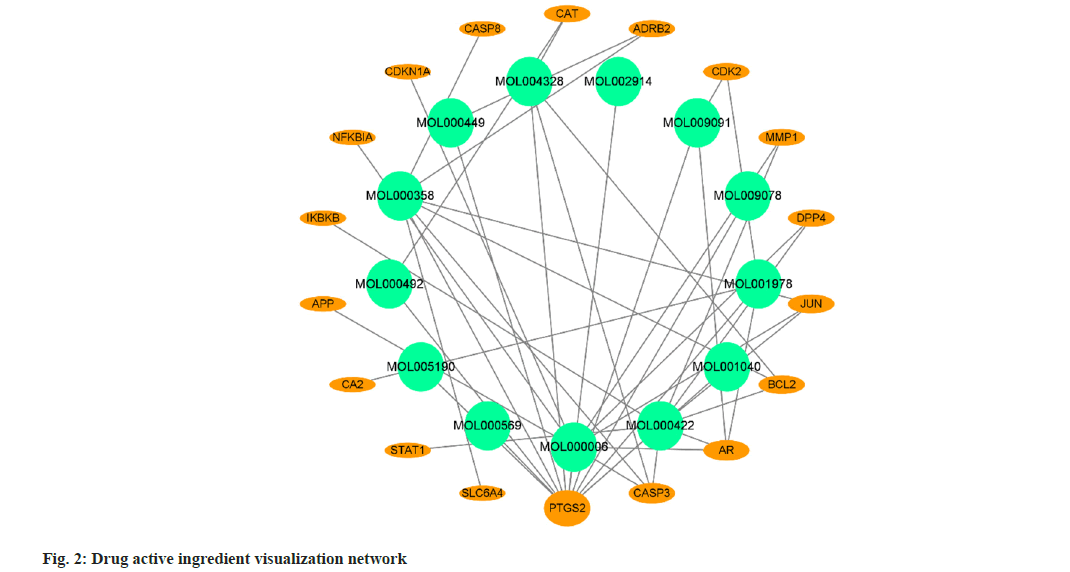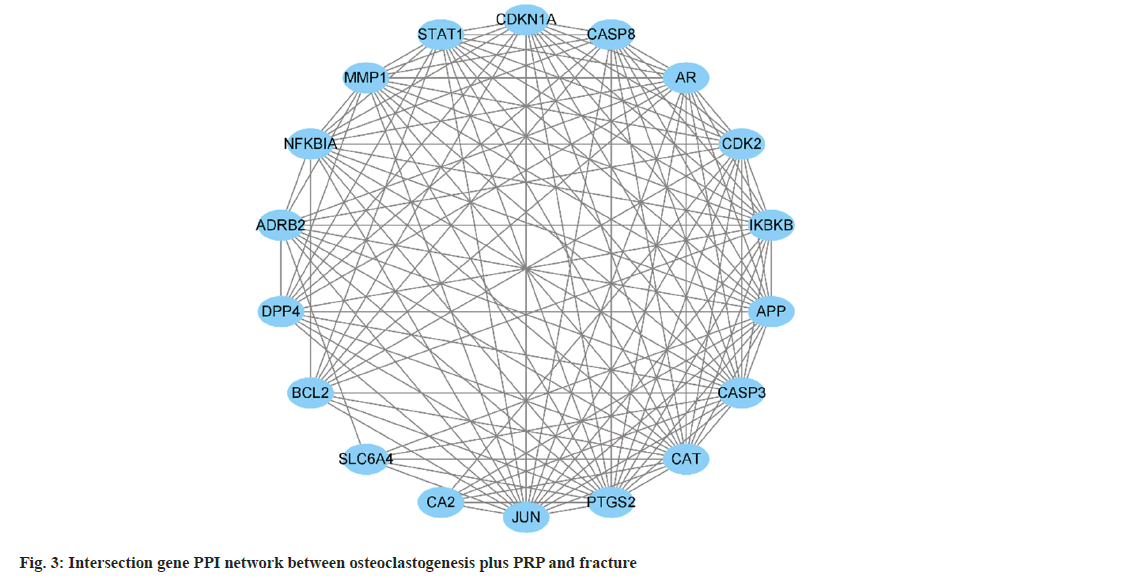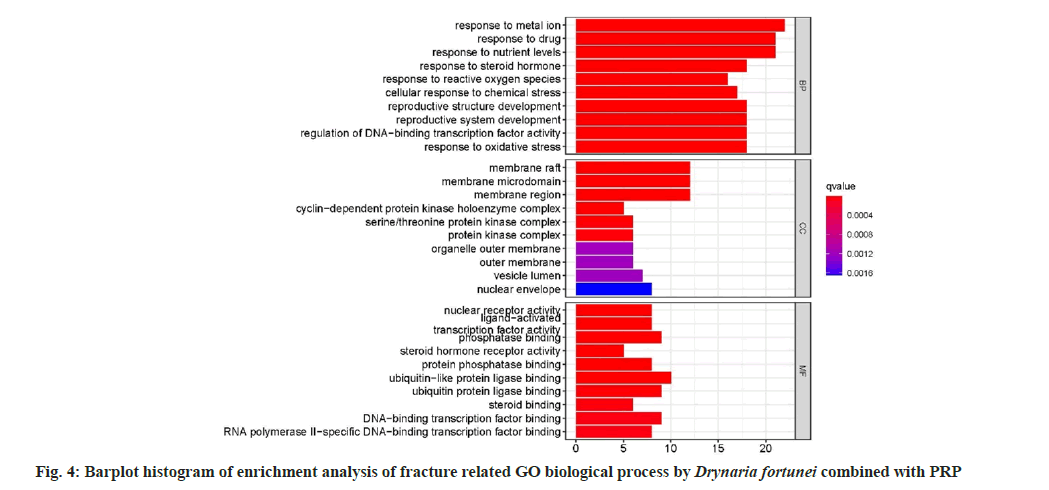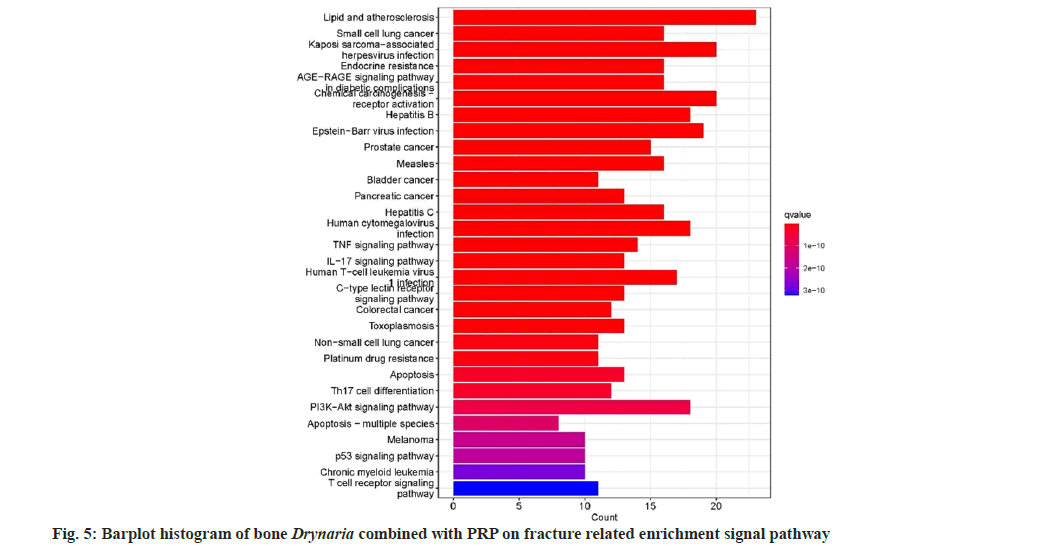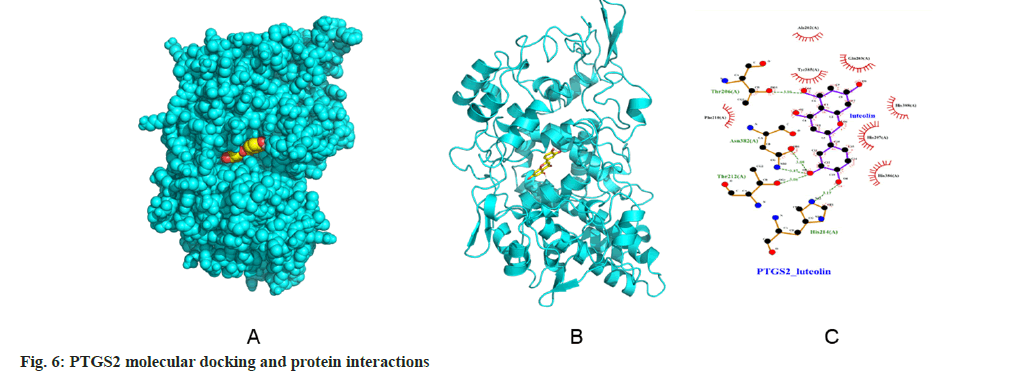- *Corresponding Author:
- Pengbo Sun
Department of Pharmacy, Wendeng Hospital of Traditional Chinese Orthopedics and Traumatology of Shandong, Wendeng, Shandong Province 264400, China
E-mail: Baoweifang001@163.com
| This article was originally published in a special issue, “Recent Progression in Pharmacological and Health Sciences” |
| Indian J Pharm Sci 2024:86(2) Spl Issue “114-121” |
This is an open access article distributed under the terms of the Creative Commons Attribution-NonCommercial-ShareAlike 3.0 License, which allows others to remix, tweak, and build upon the work non-commercially, as long as the author is credited and the new creations are licensed under the identical terms
Abstract
Based on network pharmacology and molecular docking techniques and methods, to explore the active components and potential effects of Drynaria fortunei combined with platelet-rich plasma intervention therapy on fracture healing diseases. The gene cards database, the human Mendelian genetic database, Online Mendelian Inheritance in Man database, and the DisGeNET database were searched to identify fracture-related targets. Then, the active chemical components and targets in Rhizoma Drynariae were screened through the traditional Chinese medicine systematic pharmacology and analysis platform database. Then, the characteristic genes of platelet-rich plasma were searched through the GSE203196, and the common targets of drugs and diseases were screened through R language. Construct a drug candidate compound target network diagram. Use the protein interaction network function enrichment analysis database and the Cytoscape software to build a protein interaction network, use AutoDock Vina for analysis and docking, use R language to conduct Gene Ontology and Kyoto Encyclopedia of Genes and Genomes analysis on the critical targets of the fracture of the combination of Drynaria fortunei and platelet-rich plasma intervention therapy, and determine the core target and mechanism of the variety of Drynaria fortunei and platelet-rich plasma treatment of the fracture. A total of 18 active compounds were obtained from Rhizoma Drynariae. There are 18 overlapping targets of Drynaria and platelet-rich plasma fracture. There are 13 active ingredients related to disease targets. Rhizoma Drynariae and platelet-rich plasma are mainly involved in regulating prostaglandin-endoperoxide synthase 2, androgen receptor, caspase-2, and B-cell lymphoma 2 to play a role in treating fractures. The treatment of fracture with Drynaria fortunei combined with platelet-rich plasma is a complex process of multi-components, multi-targets, and multi-pathways related to the coordinated regulation of multiple targets and signal pathways.
Keywords
Osteoclast, platelet-rich plasma, fracture healing, network-based pharmacology, multicomponent-multi target pathway
Fractures with traffic injuries as the primary causative factor[1]. Non-union of fractures not only affects patient’s physical health but also causes psychological problems and reduces patient’s quality of life[2,3]. So how to promote fracture healing and reducing the fracture's impact on patients become the key to treatment[4]. Fitting drugs that promote callus growth while fixing broken bones is a common means of treating fractures in the clinic[5]. In traditional medicine, many Chinese herbs promote bone fracture healing, such as osteoclast supplementation, Eucommia ulmoides, and sequestration[6,7]. It is also commonly used in the clinic to treat fractures by prescription-containing osteoclast supplementation. It has achieved relatively good results, but the mechanism of action of osteoclast supplementation to promote fracture healing remains incompletely defined.
Osteoclast supplementation, the dried rhizome of quercetin fern, a hydrolong orthopedic plant, was initially included in Ben Cao, picked up in the Tang Dynasty and has the efficacy of tonifying kidney and sustaining pain, and can promote fracture healing. Thus it is a medicinal remedy for the treatment of orthopedic diseases[8]. Current studies on the effects of osteoclast supplementation on factors related to promoting osteoblast proliferation have also been reported, but the numbers are relatively small. Jeong et al.[9] found that total flavonoid from osteoclast supplementation enabled Androgen Receptor (AR) messenger Ribonucleic Acid (mRNA) expression in rat osteoblasts, promoting osteoblast genesis. Xu et al.[10] showed that total flavonoids from osteoclast fragments could boost AR, mRNA expression, which might be related to the androgenetic effect, thereby inhibiting bone resorption and promoting osteogenesis.
Platelet-Rich Plasma (PRP) is a leukocyte gel prepared after autologous whole blood is extracted by centrifugation and added to thrombin because it is derived from the autologous source, has non rejection immunity, safety, and so on. In recent years, PRP has been used more frequently in bone repair, wound repair, articular cartilage injury, and sports injuries, and the clinical effects are inevitable. Upon activation, PRP has been shown to release Insulin- Like Growth Factor-1 (IGF-1), and Transforming Growth Factor-Beta (TGF-β). Several cytokines, including Platelet-Derived Growth Factor (PDGF), Vascular Endothelial Growth Factor (VEGF), and Epidermal Growth Factor (EGF), play critical regulatory roles in the repair of bone and soft tissue disorders.
At present, few studies apply the combination of Traditional Chinese Medicine (TCM) and PRP after internal fixation of bone fracture, and the author followed the mentor in the process of clinical learning to find that combining osteoclast supplementation with PRP has achieved an excellent clinical effect after fracture surgery, and the patients also have high satisfaction. Therefore, based on the methods of network pharmacology and molecular docking in this study, we explored the potential mechanism of action of osteoclast supplementation combined with PRP on bone fracture, intending to provide corresponding references for the treatment of Osteoarthritis (OA) disease.
Materials and Methods
Key active ingredient collection:
To find the constituents and drugs of TCM Panax Rhizoma using "osteoclastopanax" as the keyword in the Traditional Chinese Medicine Systematic Pharmacology (TCMSP) (http://lsp. nwsuaf.edu.cn/tcmsp.php). Chemical composition information contained. We are screening the vital active constituents of osteoclasts in terms of Oral Bioavailability (OB) and Drug-Likeness (DL). OB refers to the rate and extent to which the drug in the formulation is absorbed into human circulation. DL refers to the similarity of a compound to a known cure, both of which are important for judging a drug’s active ingredients, according to previous research standards, using OB ≥30 % and DL ≥0.18 as the criteria for screening the vital active compounds of osteoclast supplementation. The final screening resulted in 18 combinations, 13 of which were essential active compounds.
Build a network of Drynaria fortunei chemical components combined with PRP target gene fracture:
Find the protein action target of the chemical components of Rhizoma Drynariae through the TCMSP database, query the gene corresponding to the protein using the UniProt database (https:// www.Uniprot.org), summarize and obtain the critical active compound gene of Rhizoma Drynariae. At the same time, with the help of Genecards (https://www. genecards.org/), Online Mendelian Inheritance in Man (OMIM) (https://omim.org/), Pharmacogenetics Knowledge Base (PharmGKB) (https://www. pharmgkb.org/). PubMed and other databases query the gene name corresponding to the target protein of fracture disease. Input the genes of essential active compounds of Rhizoma Drynariae, PRP, and OA disease genes into R language to obtain intersection genes and Veen map.
Construction of Protein-Protein Interaction (PPI) network:
A PPI network is a protein interaction network that can reflect the interaction between proteins. Import the target genes of Drynaria, PRP, and OA to Search Tool for the Retrieval of Interacting Genes (STRING) software (https://string DB.org/) to hide free proteins. To observe the PPI network relationship, and gradually change the PPI protein score relationship values, select the appropriate PPI protein interaction relationship diagram and the files, and download them. The TSV files of the PPI network were imported into Cytoscape software to construct an optical network, and the network was analyzed using the network analyzer plug-in to identify the core proteins in the PPI network by using each score above the median as the screening condition, filtering three times.
Associated signalling pathway network construction:
Gene Ontology (GO) biological function enrichment analysis and Kyoto Encyclopedia of Genes and Genomes (KEGG) pathway enrichment analysis were performed with the bioconductor biological data package in R, following the statistical methods; p was set to 0.05, Q was set to 0.05, GO enrichment analysis and KEGG pathway enrichment analysis was performed, and the results were exported, and bar plot histograms and bubble plots were plotted, and finally analytical results discussion osteoclast genesis is a promising therapeutic mechanism for fracture.
Molecular docking analysis:
The Two-Dimensional (2D) structures of small molecule ligands and protein receptors were downloaded through PubChem (https://pubchem. ncbi.nlm.nih.gov), Protein Data Bank (PDB) (http:// www.rcsb.org/) databases, water molecules, and small molecule ligands were removed by PyMOL software, PDBQT files were prepared, and functional pockets were determined based on AutoDock Vina software was finally used to complete molecular docking validation of the interaction between the active components of osteoclastogenesis and core targets.
Results and Discussion
According to the above criteria, 18 active ingredients were obtained. These include stigma sterol, β-sitosterol, kaempferol, and other constituents. The information on the essential active compounds of radix et Rhizoma is detailed in Table 1.
| Molecular ID | Molecular name | Bioavailability | Drug property |
|---|---|---|---|
| MOL000006 | Luteolin | 36.16 | 0.25 |
| MOL000358 | Beta-sitosterol | 36.91 | 0.75 |
| MOL009076 | Cyclolaudenol | 39.05 | 0.79 |
| MOL009061 | 22-Stigmasten-3-one | 39.25 | 0.76 |
| MOL009075 | Cycloartenone | 40.57 | 0.79 |
| MOL009091 | Xanthogalenol | 41.08 | 0.32 |
| MOL002914 | Eriodyctiol (flavanone) | 41.35 | 0.24 |
| MOL009063 | Cyclolaudenol acetate | 41.66 | 0.79 |
| MOL000422 | Kaempferol | 41.88 | 0.24 |
| MOL001040 | (2R)-5,7-dihydroxy-2-(4-hydroxyphenyl) chroman-4-one | 42.36 | 0.21 |
| MOL000449 | Stigmasterol | 43.83 | 0.76 |
| MOL001978 | Aureusidin | 53.42 | 0.24 |
| MOL000492 | (+)-Catechin | 54.83 | 0.24 |
| MOL004328 | Naringenin | 59.29 | 0.21 |
| MOL000569 | Digallate | 61.85 | 0.26 |
| MOL009078 | Davallioside A_qt | 62.65 | 0.51 |
| MOL009087 | Marioside_qt | 70.79 | 0.19 |
| MOL005190 | Eriodictyol | 71.79 | 0.24 |
Table 1: Key active compound constituents of radix et Rhizoma
A total of 1395 target genes related to fracture were searched through GeneCards, OMIM, PharmGKB, Therapeutic Target Database (TTD), and DrugBank databases, and the target genes of osteoclast, PRP, and fracture were imported into R language to obtain the targets of osteoclast combined with PRP intervention therapy on fracture healing. The Venn diagram was drawn (fig. 1). The above targets were the key targets of related signaling pathways for downstream bioinformatics analysis.
The intersection genes and 13 essential compounds obtained were imported into Cytoscape software to construct a drug disease visualization network as shown in fig. 2, and a total of 35 nodes (18 genes, 13 key compounds) and 75 edges. The green triangle of the triangle indicates 13 key compound components, namely, luteolin, beta-sitosterol, cycloartenol, 22-stigmasten-3-one, cycloartenol, xanthogalenol, eriodynactiol (flavanone), cycle occurring enol acetate, kaempferol, (2R)-5,7-dihydroxy-2-(4- hydroxyphenyl) chroman-4-one, davallioside_qt, marioside_qt, and eriodictyol. Blue boxes represent 18 intersection genes. In the above network, the degree value of each node represents the number of route strips connected between nodes in the drugdisease network graph. The larger the degree value of a node, the more likely it is to be a hub node in the network. The top 4° were Prostaglandin- Endoperoxide Synthase-2 (PTGS2), GASP3, AR, and B-Cell Lymphoma 2 (BCL2), which could act with 11, 4, 4, and 3 compounds, respectively. In the analysis based on the topological properties of the above networks, we can find that the essential compounds of osteoclastogenesis have regulatory effects on multiple targets. This regulatory effect reflects the diversity of drug targets and the synergism of biological networks.
Eighteen intersection genes obtained from targeting intersection genes were input into STRING software. Finally, the PPI protein score relationship was determined to be 0.9, resulting in fig. 3, in which nodes represent associated proteins, and each edge represents a PPI relationship. The higher the number of advantages indicates, the more likely it is to be a core protein. Then, the top-ranked 18 protein structure network diagram was selected, such as fig. 4, and its protein names were Jun PTGS2, Catalase (CAT), Caspase 3 (CASP3), Amyloid Precursor Protein (APP), Inhibitor Of Nuclear Factor Kappa B Kinase subunit Beta (IKBKB), Cyclin Dependent Kinase 2 (CDK2), AR, Caspase 8 (CASP8), Cyclin Dependent Kinase Inhibitor 1A (CDKN1A), Signal Transducer and Activator of Transcription 1 (STAT1), Matrix Metallopeptidase 1 (MMP1), Nuclear Factor Kappa B (NF-κB), Inhibitor Alpha (NFKBIA), Adrenoceptor Beta 2 (ADRB2), Dipeptidyl Peptidase 4 (DPP4), BCL2 and Solute Carrier Family 6 Member 4 (SLC6A4). These proteins play a vital role in the treatment of bone fractures.
The GO enrichment analysis results show that 114 GO biological processes has been obtained. According to the number of enrichments, the top ones mainly respond to metal ions, membrane rafts, and nuclear receiver activity. Fig. 5 shows the enrichment analysis of the total 10 GO biological processes. It can be seen from this figure that the effect of bonecrushing and tonifying on fracture treatment can be achieved through multiple natural regulation.
The top 30 signaling pathways were extracted, and the barplot bar chart (fig. 5) was drawn according to the critical target genes mainly enriched in 75 ways (p<0.05) by target pathway analysis (KEGG) of the 75 signaling pathways closely related to bone fracture, including 17 signaling courses involving Interleukin 17 (IL-17), apoptosis, Phosphoinositide 3-Kinase (PI3K)/Protein Kinase B (AKT) and other multiple signaling pathways. This indicates that the treatment of bone fragmentation and fracture involves regulating different signaling pathways and that the signaling pathways are interrelated, reflecting the cooperativity among signaling pathways.
The top 1 PPI network core protein (PTGS2) obtained was selected with its corresponding active compound ingredients to perform molecular docking validation (fig. 6). The results of molecular docking showed that the protein molecules involved in the critical targets of bone fracture treated by osteoclastogenesis combined with PRP had a better anastomosis and were able to form an optimal complex osteoclastogenesis combined with PRP could work by regulating targets such as PTGS2.
Based on the theory of "holistic concept" and "systems biology" of TCM and network pharmacology, network pharmacology provides theoretical and technical support for studying the mechanism of action of TCM and the development of new drugs in TCM by constructing a "TCM component disease target" four-dimensional graph and systematically analyzing the targets of TCM’s ingredients acting on diseases to deeply study the functions and pathways involved in TCM disease targets.
In this study, we showed that the main effective ingredients of osteoclast supplementation combined with PRP could affect the occurrence of bone fracture through multiple targets and signaling pathways. The core genes involved in the therapeutic effect of osteoclast plus PRP on bone fracture mainly include Jun PTGS2, CAT, CASP3, APP, IKBKB, CDK2, AR, CASP8, CDKN1A, STAT1, MMP1, NFKBIA, ADRB2, DPP4, BCL2, SLC6A4, which can affect nuclear receptor activity, ligand-activated, response to the drug, steroid hormone receptor activity, protein phosphatase binding, ubiquitin-like proteinligand binding, ubiquitin protein ligase binding, RNA polymerase II-specific Deoxyribonucleic Acid (DNA) binding transcription factor binding, etc., i.e. mainly affecting cytokines and cytokine receptors, endocrine factors, transcription factors, etc., to promote bone fracture healing at the molecular level[11].
The KEGG pathways of the core genes of fracture were numerous in treatment with osteoclast supplementation. These pathways mainly included the prostate cancer signaling pathway, atherosclerosis signaling pathway, Tumor Necrosis Factor (TNF) signaling pathway, Advanced Glycation End Product Receptor (AGER) signaling pathway of diabetic complications, apoptosis signaling pathway, hepatitis C signaling pathway, hepatitis B signaling pathway, and so on[12,13]. The downstream pathways of prostate cancer signaling pathways include apoptosis signaling pathways. Chen et al.[14] and Zhang et al.[15] used androgen blockade to treat prostate cancer patients and rats, respectively, and found that it can lead to osteoporosis in prostate cancer patients and rats. However, the specific mechanism of action is still unclear. Downstream atherosclerotic signaling pathways include NF-κB signaling pathway, Mitogen-Activated Protein Kinase (MAPK) signaling pathway, apoptosis signaling pathway, etc.,[16]. Zhu et al.[17] administered naringin to ovariectomized rats with osteoporotic fracture and concluded that naringin improved Bone Mineral Density (BMD), Bone Volume (BV), BV/Total Volume (BV/TV), and Tuberculosis (TB). The osteoporotic fracture site in rats promoted the healing of the fracture site. The mechanism may be achieved by inhibiting BCL- 2, mRNA expression, promoting Bcl-2 Associated X-protein (BAX), mRNA expression, activating CASP3, and promoting osteoclast apoptosis[18]. The downstream signaling pathways of TNF signaling include MAPK signaling pathway, NF-κB signaling pathway, apoptotic signaling pathway, etc.,[19,20]. Johnston et al.[21] administered oral facial bone capsules to patients with senile osteoporosis and found that serum levels of IL-6. TNF-α significantly decreased and improved low back pain in elderly patients with osteoporosis. Its action reduces bone destruction and cytokine production and inhibits bone resorption. Soliman et al.[22] measured femoral neck BMD and IL-6, TNF-in fasting patients with cirrhosis after hepatitis C α levels. We found that the femoral neck BMD of cirrhotic patients with post-c liver cirrhosis was significantly lower in IL- 6, TNF-α. The levels were significantly increased, which might be related to the increased expression of IL-6, TNF-α, and other bone resorption factors involved in the osteoclast’s activation.
To sum up, the mechanism of the treatment of fracture with the combination of bone-crushing and tonifying, and PRP is that multiple active ingredients in bone-crushing and tonifying regulate fracturerelated genes, and fracture-related genes further regulate various signal pathways. Finally, under the combined effect of multiple signal pathways, the body shows the corresponding phenotype; TCM ingredient disease target phenotype. It is worth noting that this phenotype is not only affected by TCM but also by the internal and external environment, primary diseases, etc. Therefore, we should keep the internal and external environment stable, control primary conditions, and strive to maximize the effect of TCM. Network pharmacology provides ideas for discovering new pathways, regulating highly enriched genes and signal pathways to treat diseases, and comprehensively understanding the relationship between TCM and diseases. Network pharmacology opens the door to the modernization research of TCM and will undoubtedly promote the development of TCM.
Funding:
The project was supported by Young Research Foundation of Shandong Pharmaceutical Association and Tianji Health Care under the project “Study on the clinical effect of TCM Jiegu Formula combined with PRP intervention therapy on fracture healing” (No: hlyy2021-010).
Conflict of interests:
The authors declared no conflict of interests.
References
- Tent PA, Juncar RI, Lung T, Juncar M. Midfacial fractures: A retrospective etiological study over a 10-year period in Western Romanian population. Niger J Clin Pract 2018;21(12):1570-5.
[Crossref] [Google Scholar] [PubMed]
- Wildemann B, Ignatius A, Leung F, Taitsman LA, Smith RM, Pesántez R, et al. Non-union bone fractures. Nat Rev Dis Primers 2021;7(1):57.
[Crossref] [Google Scholar] [PubMed]
- Johnson L, Igoe E, Kleftouris G, Papachristos IV, Papakostidis C, Giannoudis PV. Physical health and psychological outcomes in adult patients with long-bone fracture non-unions: Evidence today. J Clin Med 2019;8(11):1998.
- Marongiu G, Dolci A, Verona M, Capone A. The biology and treatment of acute long-bones diaphyseal fractures: Overview of the current options for bone healing enhancement. Bone Rep 2020;12:100249.
[Crossref] [Google Scholar] [PubMed]
- Liu J, Zhang J, Lin X, Boyce BF, Zhang H, Xing L. Age-associated callus senescent cells produce TGF-β1 that inhibits fracture healing in aged mice. J Clin Invest 2022;132(8):e148073.
[Crossref] [Google Scholar] [PubMed]
- Zhao Y, Tan DC, Peng B, Yang L, Zhang SY, Shi RP, et al. Neuroendocrine-immune regulatory network of Eucommia ulmoides oliver. Molecules 2022;27(12):3697.
[Crossref] [Google Scholar] [PubMed]
- Shen W, Luo H, Xu L, Wu Z, Chen H, Liu Y, et al. Wnt5a mediates the effects of Bushen Huoxue decoction on the migration of bone marrow mesenchymal stem cells in vitro. Chin Med 2018;13(1):1-9.
[Crossref] [Google Scholar] [PubMed]
- Zhang T, Han W, Zhao K, Yang W, Lu X, Jia Y, et al. Psoralen accelerates bone fracture healing by activating both osteoclasts and osteoblasts. FASEB J 2019;33(4):5399-410.
[Crossref] [Google Scholar] [PubMed]
- Jeong JC, Lee JW, Yoon CH, Lee YC, Chung KH, Kim MG, et al. Stimulative effects of Drynariae Rhizoma extracts on the proliferation and differentiation of osteoblastic MC3T3-E1 cells. J Ethnopharmacol 2005;96(3):489-95.
[Crossref] [Google Scholar] [PubMed]
- Xu P, Lin B, Deng X, He S, Chen N, Wang N. Anti-osteoporosis effects of Anemarrhenae Rhizoma/Phellodendri Chinensis Cortex herb pair and its major active components in diabetic rats and zebrafish. J Ethnopharmacol 2022;293:115269.
[Crossref] [Google Scholar] [PubMed]
- Liang B, Burley G, Lin S, Shi YC. Osteoporosis pathogenesis and treatment: Existing and emerging avenues. Cell Mol Biol Lett 2022;27(1):72.
[Crossref] [Google Scholar] [PubMed]
- Xu B, Zhou Y, Wang Q, Liu Y, Zhang L, Wang S, et al. Use of network pharmacology and molecular docking methods to elucidate the curative effect of Epimedium–Anemarrhen on osteoporosis. Nat Product Commun 2022;17(3):1934578X221086904.
- Dai W, Sun Y, Zhong G. A network pharmacology approach to estimate the active ingredients and potential targets of Cuscutae Semen in the treatment of osteoporosis. Med Sci Monit 2020;26:e920485-1.
[Crossref] [Google Scholar] [PubMed]
- Chen JF, Lin PW, Tsai YR, Yang YC, Kang HY. Androgens and androgen receptor actions on bone health and disease: From androgen deficiency to androgen therapy. Cells 2019;8(11):1318.
[Crossref] [Google Scholar] [PubMed]
- Zhang L, Zhang Y, Zhao J, Yuan Y, Wen Y, Lian J, et al. A metabolomics study of Qianliexin capsule treatment of benign prostatic hyperplasia induced by testosterone propionate in the rat model. Anal Biochem 2021;628:114258.
[Crossref] [Google Scholar] [PubMed]
- Duan H, Zhang Q, Liu J, Li R, Wang D, Peng W, et al. Suppression of apoptosis in vascular endothelial cell, the promising way for natural medicines to treat atherosclerosis. Pharmacol Res 2021;168:105599.
[Crossref] [Google Scholar] [PubMed]
- Zhu Z, Xie W, Li Y, Zhu Z, Zhang W. Effect of naringin treatment on postmenopausal osteoporosis in ovariectomized rats: A meta-analysis and systematic review. Evid Based Complement Alternat Med 2021;2021:1-8.
- Karim K, Giribabu N, Salleh N. Marantodes pumilum (blume) Kuntze (Kacip Fatimah) leaves aqueous extract prevents downregulation of Wnt/β-catenin pathway and upregulation of apoptosis in osteoblasts of estrogen-deficient, diabetes-induced rats. J Ethnopharmacol 2021;280:114236.
[Crossref] [Google Scholar] [PubMed]
- Chen Y, Zhang L, Li Z, Wu Z, Lin X, Li N, et al. Mogrol attenuates osteoclast formation and bone resorption by inhibiting the TRAF6/MAPK/NF-κB signaling pathway in vitro and protects against osteoporosis in postmenopausal mice. Front Pharmacol 2022;13:803880.
[Crossref] [Google Scholar] [PubMed]
- Shan LS, Su J, Zhang Y, Wen HX, Ping WX, Cong HM, et al. Benefits and mechanisms of polysaccharides from Chinese medicinal herbs for anti-osteoporosis therapy: A review. Int J Biol Macromol 2021;193:1996-2005.
[Crossref] [Google Scholar] [PubMed]
- Johnston CB, Dagar M. Osteoporosis in older adults. Med Clin 2020;104(5):873-84.
[Crossref] [Google Scholar] [PubMed]
- Soliman AT. Study of growth and bone mineral density and factors affecting them in children and adolescents with thalassaemia major and sickle cell disease. University of South Wales (United Kingdom); 1998.
